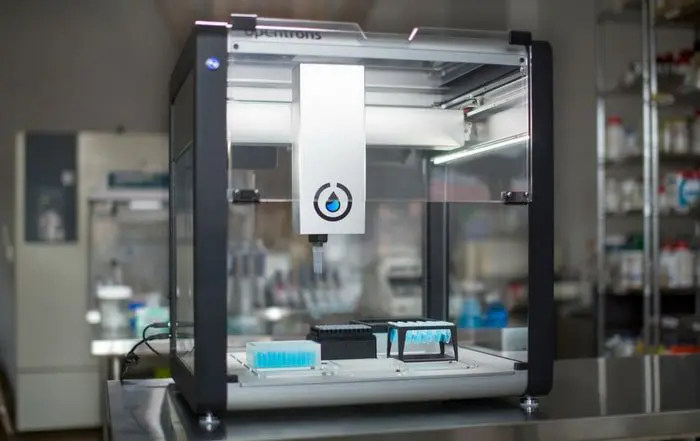
Dr. Annabel Shang is blazing new trails at MilliporeSigma, a company dedicated to making research and biotech production simpler, faster, and safer. The work involves intensive pipetting – a job that the Opentrons OT-2 has been handling capably since February 2019. We talked with Annabel to find out how the OT-2 helps her improve processes and boost productivity.

Dr. Annabel Shang in her lab at MilliporeSigma with her OT-2. CREDIT: Annabel Shang
Opentrons: Please tell us a little about your background.
Annabel Shang: I’m a scientist working in membrane chromatography research and development for protein purification, and I earned my Ph.D. degree in chemical engineering from McMaster University.
Opentrons: What kind of research do you do?
Annabel: Since joining MilliporeSigma nearly two years ago, I have focused on creating antibody drugs, with extensive studies using ELISAs (enzyme-linked immunosorbent assay) to detect and quantify substances such as antibodies and proteins.
Opentrons: What’s a typical day in the lab for you?
Annabel: We need to ensure the samples have minimal impurities, and we use the robot for purity testing techniques with Host Cell Protein (HCP) and Protein A ELISA kits. These require pipetting, dilutions, and transferring liquid from one place to another.
Opentrons: What else is good or bad about your OT-2?
Annabel: Purity testing is not our routine work, but we have done as many as three of these assays in a week. We have to manually dilute our samples and transfer them onto the microplate. These are the most painful steps, which consume at least two hours. Before, I had to leave one whole day for one ELISA run.
While the robot is running by itself, I can save two hours per assay in tedious sample dilution and liquid transfer.
Now, the robot frees my hands. I don’t need to be occupied by the ELISA; I can set it up and go. While the robot is running by itself, I can save two hours per assay in tedious sample dilution and liquid transfer. It’s much faster than if I used my hands to do it, and allows me to make much more efficient use of my waiting time in other work, and just do the ELISA on the side.
I’m also very happy with the accuracy, which is higher than manual tests, and reduces the need to repeat.
Opentrons: Can you tell us more about how the OT-2 frees your hands?
Annabel: These assays require a lot of physical arm movement and finger pressing, which can easily cause neck and back pain as we keep one posture for a long time. They also require high-attention and focus, which makes people feel exhausted afterwards. But with the OT-2, minimal physical or mental effort is needed, which is good for operators who have bad neck and back issues, and for maintaining our focus and energy levels.

Dr. Annabel Shang working on her OT-2. CREDIT: Annabel Shang
Opentrons: Did you have any challenges setting up the robot?
Annabel: We did have one challenge. While doing the initial calibration, the tip was supposed to move toward the sensor, touch five spots, and bounce away, but after touching one of the spots, instead of bouncing away, it pressed down so deep that the tip bent. Technical support sent me a new sensor, which works normally.
I’m happy with Opentrons technical support; they reply on time, they are nice and patient, and they really try to help solve problems. When you know nothing about the robot and you have no help, [you’ll be] happy with that.
Opentrons: Had you used any lab automation before your OT-2?
Annabel: No, I didn’t have any experience with lab robots. I’ve always done pipetting manually, and it’s very intensive work.
Opentrons: Are you planning any other automation?
Annabel: No. We use the OT-2 mainly to do the ELISA kit. For now, I don’t see other applications, but we are glad to use it for such tedious work.
Opentrons: Is there anything else you’d like to say about using the OT-2?
Annabel: The robot looks very nice. It makes our lab look modern. Everybody is interested in it. They ask me “What is this?” and “What can you do with it?” They see the arm moving, and they get very excited